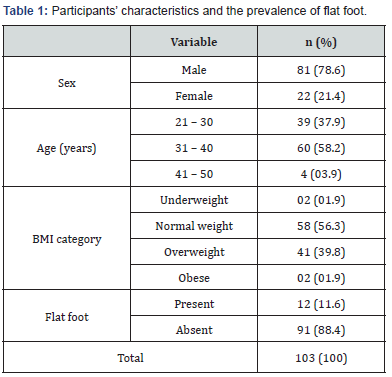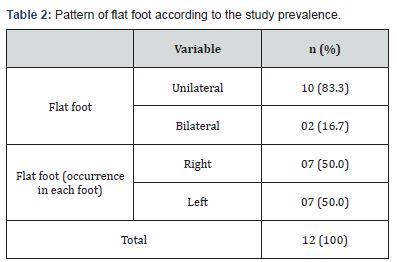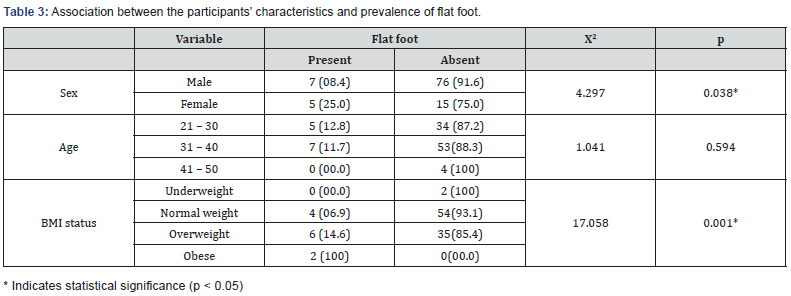Arthritis & Bone Research - Juniper Publishers
Abstract
Introduction: Adult flat foot poses a challenge to health professionals and could lead to major life impediments. There is scant literature on this disorder in local communities and none has considered road traffic officials.
Objective: This study sought to determine the prevalence of flat foot among Nigerian road traffic officials and discover its association with their personal characteristics.
Methods:A cross-sectional design was used to recruit 103 adults (81 males and 22 females) who were between the ages of 21 and 50 years. The plantar arch index was used to diagnose flat foot via the exploration of foot prints. Data were analysed using descriptive and inferential statistics.
Results:The prevalence of flat foot was 11.6%, which mostly had a unilateral pattern among the participants. A significant association was observed between sex and flat foot prevalence (p = 0.038), revealing a higher ratio of affected females to males. There was not a similar finding on analysis with the participants’ age (p = 0.594). Furthermore, a significant association existed between increased BMI and flatfoot prevalence (p = 0.001).
Conclusion: This study among road traffic officials disclosed a prevalence rate that is comparable to other adult populations. Overweight/obese and female officials exhibited a greater risk of this disorder, so should be given special attention. Proactive efforts towards its screening, prevention and monitoring are recommended.
Keywords: Flat foot; Road traffic officials; Prevalence; Plantar arch index
Introduction
The foot is a complex structure which plays an important role in the lower limb’s processes of providing support, balance and propulsion [1]. Consistent measurements can be used to ascertain foot types based on their arches, as these describe the foot’s plantar surface contact area [2], and ultimately aid in the detection of flat foot [3].
Flat foot or pes planus, which denotes the complete or near-complete contact of the sole with the floor due to fallen foot arches, could be flexible or rigid [4]. The former is regarded as a paediatric developmental incidence that may persist into adulthood, typically with no symptoms [5] but provides a higher risk of musculoskeletal injury [6]. Rigid flat foot however, is often a complex disorder in adults which could arise from acquired causes comprising of traumatic, degenerative and neuromuscular conditions [7]. Literature reveals that adult pes planus poses a common challenge to healthcare professionals [8] and it could result in major life impediments via severe pain and disability [7].
The prevalence of adult flat foot has been investigated by different authors [9-13] who obtained diverse results. Notable discrepancies exist on its association with BMI, age and/or sex, as revealed by other authors [14-16]. These differences extend to Nigeria as some researchers have also reported contrasting prevalence of flat foot in adults [17-20], however there is a consensus amongst them on a higher prevalence among Nigerian women. Generally, a dearth of literature is still evident on this disorder as it has not been explored as much as paediatric flat foot. Furthermore, paramilitary or road traffic organizations have not been considered in the available studies.
There seems to be no literature on pes planus or anthropometric data on the feet of Nigerian road traffic officials, despite some information on work-related impediments on similar indigenous personnel [21]. In order to monitor flat foot and manage its occurrence as well as associated impairments on this population, it is important to collate and explore relevant data. Hence, this study was executed to determine the prevalence of flat foot among Nigerian road traffic officials and discover its association with their personal characteristics.
Materials and Methods
Research Design
A cross-sectional descriptive design was utilised for this study. Participants were recruited through purposive sampling technique in the Federal Road Safety Corps (FRSC) Enugu sector command in Enugu State, Nigeria. Officials were identified from the staff register, educated and invited for an assessment procedure in order to ascertain their eligibility to participate in the study. Inquiries about any previous foot surgery and pain or wobbly sensation whilst standing, walking or moving the foot, was part of the procedure. It also involved a physical assessment for foot deformities, amputations, open wounds and dislocations/ fractures. A list of eligible officials was drawn up after this procedure, including those who did not report or display factors that would militate against their involvement.
Participants
A total of 103 adults, aged between 21 and 50 years, comprising of 81 males and 22 females who were officials of the FRSC Enugu sector command participated in the study. Ethical approval was obtained from the hospital health research/ethics committee and permission got from the Commander, FRSC Enugu sector command before commencing the study. The officials were fully educated about the study objectives and procedure for data collection, highlighting the need for volunteers. Informed consent was duly obtained from those who were willing to participate. Officials with either unilateral flat foot, bilateral flat foot or normal feet were included in the study whilst those with other foot deformities, had previous surgeries and other orthopaedic/ neurological conditions were excluded. The participants assembled in groups during their respective free periods and had their details as well as measurements taken. All the data were meticulously recorded and kept confidential.
Measurements
Standing upright and barefooted, the height of the participants was obtained using a stadiometer (in cm) whilst their weight was measured with a weighing scale (in kg). The feet of these officials were then sanitised for the following diagnostic procedure:
In the sitting position, the plantar arch Index (PI) was obtained via a specific routine based on previous literature [3,22-25]. Each official had to dip one foot on a pad adequately dampened with ink, stand up and firmly print the foot on a sheet of paper attached to a platform whilst flexing the ipsilateral knee slightly (upto 30°). This procedure was repeated to obtain the print of the contralateral foot and then, these footprints were used to calculate the PI for both feet via a validated method [26]. First, a line was drawn tangent to the medial forefoot edge and the heel region, its midpoint determined and a perpendicular line intersecting the footprint drawn from it. This was also performed for the heel tangency point. Next, two perpendicular distances X and Y were measured (X; representing the breadth spanning the medial to lateral edges of the midfoot and Y; representing the breadth spanning the medial to lateral edges of the rearfoot). Lastly, the value of X was divided by the value of Y to derive the PI. A normal PI is one encompassed within 2 standard deviations (SD) of the population mean [23]. PI values equal or above the total of 2SD with the mean were taken as indicative of flat foot.
Data Analysis
SPSS Software version 23 for Windows (IBM, Chicago, IL, USA) was used to analyse the data obtained in this study. Prevalence of flat foot, its pattern and the participants’ characteristics were presented descriptively in tabular form by using percentage frequencies. Association between flat foot prevalence and personal characteristics was examined using the Chi-square test. The level of significance was set at p<0.05 for these tests.
Results
Participants’ characteristics, prevalence and pattern of flat foot
A total of 103 road traffic officials of the FRSC Enugu sector command participated in this study. Table 1 shows the participants’ demographic profile which consists of 81 (78.6%) males and 22 (21.4%) females; mostly within 31 – 40 years (58.2%) and falling in the normal weight category (56.3%). It further displays that the prevalence of flat foot in this population was 11.6%. Table 2 reveals that flat foot mostly had a unilateral pattern (83.3%) with an equal occurrence in each foot (50%).


Association between Personal Characteristics and Prevalence of Flat Foot
The association between the participants’ characteristics and the prevalence of flat foot is presented in Table 3. A significant association was observed between sex and the prevalence of flat foot (p = 0.038). Notably, 25% of the females had flat foot while it was present in only 8.4% of the males. There was not a significant association between the participants’ age and the prevalence of flat foot (p = 0.594). Furthermore, a significant association existed between BMI status and the prevalence of flat foot (p = 0.001). This prevalence was highest (100%) in obese participants and much lower (6.9%) in those with normal weight while underweight officials did not have flat foot.

Discussion
Prevalence and Pattern of Flat Foot
The prevalence of flat foot in this study was revealed to be 11.6%, with a high unilateral occurrence observed among the participants. A similar finding of 11.25% reported by Bhoir et al. [11] concurs with the above result. However, these authors only reported that flat foot existed bilaterally. Dissimilar prevalence rates of 5.2% among 500 participants [10] and 13.6% within 250 students [9] have been observed in Asian adults, but it should be noted they used different methods to detect flat foot. Another Asian research which used the same method as this study [13] reported a higher prevalence rate of 39.7%, however its diagnosis was based on a given normal range and not in line with the 2SD criterion. Indigenous research discloses distinct results, with the closest prevalence of 13.4% and 13.9% reported by Eluwa et al. [19] and Ukoha et al. [17] respectively. Both researchers reported a higher presentation of bilateral flat foot among 18 to 30-yearold students.
Other local authors have also obtained contrasting results to this study’s finding by stating prevalence rates of 22.2% in a 2008 study [18] and 25.3% in a later research [20] on different adult populations, with the previous authors observing a greater bilateral flat foot occurrence. The latter research involved adults within a similar age range as this present study’s participants while every afore mentioned study comprised adults younger than 30 years. This fact about age, as well as the use of various diagnostic methods, might account for the discrepancy in flat foot prevalence revealed by the present finding. Nonetheless, the observed prevalence does not connote any deviation among road traffic officials.
Association with sex
This study revealed that flat foot was three times more prevalent in females than males; as sex displayed a significant association. It is consistent with previous reports of a higher prevalence of flat foot among Nigerian women [17-20], though they had a lesser ratio of affected females to males and did not consider an association. The higher ratio of 3:1 in this study could be as a result of a smaller sample with a variance in the number of each sex and not due to any circumstance pertaining to these road traffic officials. Other authors have not found a significant association between sex and flat foot prevalence [11,12] among Indian and Spanish residents respectively. Further contrasting this study’s finding, some researchers discovered a significant association of flat foot with male gender [14] while others who assessed 284 students reported a higher prevalence among males [13]. Nigerian authors have revealed the presence of sexual dimorphism in adult foot anthropometry [27-29] which might account for the higher flat foot prevalence among females, as this sex could possess a contributory feature. They observed that males had longer and broader feet which concurs with a US study that also revealed that females had shorter but higher arches, indicating the need for more foot support [30]. A study in England further revealed the existence of osteological differences between the feet of each gender, stating the potential susceptibility of the female foot to hallux valgus deformity [31]. It would be interesting to determine if there is indeed a link between sexual dimorphism and flat foot among Nigerian women, then specifically explore such finding in road traffic officials.
Association with BMI
Findings demonstrated that flat foot was more prevalent in the higher BMI statuses, especially among the obese participants. Similar reports which also depict a significant association between BMI and flat foot have been given by several authors in different countries [12,14-16]. These studies provided consistent observations of most flat-footed individuals having greater BMI. Conversely, other authors have revealed that there was not a significant correlation between the values indicative of flat foot and BMI among young adults [9,11]. One of these studies incorporated the navicular drop test while the other considered the arch index alongside other measures to diagnose flat foot
Some postulations of an increase in body weight and BMI influencing the foot arch [1,15] offer an explanation of this present finding. Other researchers have further stated that superfluous fat deposition causes pressure over foot arches [32] and that obesity affects the foot via excessive mechanical loading during walking [33]. These raise a query about a possible collapse and flattening of the foot arch. It is therefore pertinent to properly examine this study’s finding on indigenous adults to attain an accurate understanding. Nonetheless, there was not an extraordinary prevalence of flat foot, especially among the normal or underweight road traffic officials, which would have denoted an adverse manifestation in this population.
Clinical Implications
This study’s findings draw attention to the need for careful road traffic personnel screening, as well as keeping accurate records, to detect flat foot and identify relevant data associated with its prevalence in adults. Overweight/obese and female officials displayed a higher risk of this disorder; hence they should be given special attention. Constant monitoring to limit strain at occupational tasks and ensuring proper fit of work boots are recommended, as these might help prevent and manage flat foot among this population. Appropriate nutritional, exercise and enlightenment programmes are relevant for holistic management. This study’s authors also suggest that proper foot evaluation and consideration be given to obese women, as a primary step towards tackling indigenous adult flat foot prevalence.
Limitations
There is a need for a longitudinal study which would comprise more officials and consider the possible influence of work-related factors; as this preliminary research could not incorporate these aspects. Causal inferences cannot be made from this crosssectional study’s findings.
Conclusion
This study provided data on flat foot among road traffic officials, revealing a prevalence rate of 11.6%. Overweight/obese and female officials exhibited a higher risk of this disorder, so should be given attention. Regular and proactive efforts towards screening, prevention as well as monitoring of flat foot in this population are recommended.
Click here: https://juniperpublishers.com/ntab/index.php
Click here: https://juniperpublishers.com/index.php





No comments:
Post a Comment